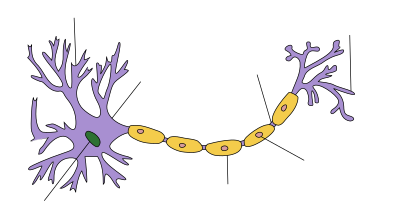Dendrite
| Dendrite |
|---|
Dendrites (from Greek δένδρον déndron, "tree") (also dendron) are the branched projections of a neuron that act to propagate the electrochemical stimulation received from other neural cells to the cell body, or soma, of the neuron from which the dendrites project. Electrical stimulation is transmitted onto dendrites by upstream neurons (usually their axons) via synapses which are located at various points throughout the dendritic tree. Dendrites play a critical role in integrating these synaptic inputs and in determining the extent to which action potentials are produced by the neuron.
Dendrites are one of two types of protoplasmic protrusions that extrude from the cell body of a neuron, the other type being an axon. Axons can be distinguished from dendrites by several features including shape, length, and function. Dendrites often taper off in shape and are shorter, while axons tend to maintain a constant radius and be relatively long. Typically, axons transmit electrochemical signals and dendrites receive the electrochemical signals. Although, some types of neurons in certain species lack axons and simply transmit signals via their dendrites. Dendrites provide an enlarged surface area to receive signals from the terminal buttons of other axons, and the axon also commonly divides at its far end into many branches (telodendria) each of which ends in a nerve terminal, allowing for a chemical signal to pass simultaneously to many target cells. Synapses involving dendrites can be axodendritic, involving an axon signaling to a dendrite, or dendrodendritic, involving signaling between dendrites. Dendritic branching is also called "dendritic arborization" and "dendritic ramification." (The term "dendritic arborization" describes the branching of dendrites as looking like the many branches of a tree.)
When an electrochemical signal stimulates a neuron it causes changes in the electrical potential across the neuron’s plasma membrane. This change in the membrane potential will passively spread across the dendrite but becomes weaker with distance without an action potential. The action potential propagates the electrical activity along the membrane of the dendrite to the cell body and then afferently down the axon to the terminal buttons where it crosses the synapse.
...
Wikipedia

